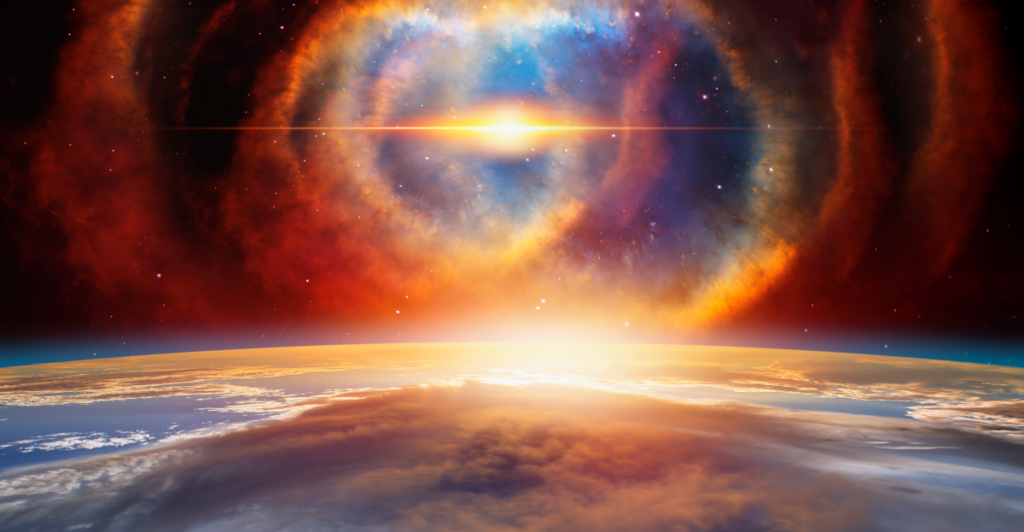Cosmic Chemistry and the Origin of Life
In his new book, Christian de Duve examines the molecular mechanisms common to all known organisms and ponders the inevitability of life as we know it.
Published July 7, 2006
By Linda Wilbrecht, PhD
Academy Contributor

The basics of biochemistry and molecular biology are often taught using lists and multiple choice exams that do little to inspire the imagination. The everyday details of these disciplines acquire a poignant significance, however, when you stop to wonder how the intricacies of life’s machinery first emerged.
In April 2006, on a break from his two laboratories in Belgium and New York, esteemed Nobel Prize-winner Christian de Duve introduced his new book, Singularities: Landmarks on the Pathways of Life, to The New York Academy of Sciences (the Academy).
As a specialist in cell and molecular biology de Duve has spent many of his nearly 89 years pondering these details, and in his talk at the Academy he reminded us what the cell’s machinery can tell us about the past, explaining, “The history of life is written into present day organisms but in very fine print and it is not easy to read. We are just beginning to be able to read it.”
A Biological Mystery Searching for Clues
The book can be read as a biological mystery story searching for clues lingering in the present day world that shed light on the origin of life. Although there is currently enormous diversity in living species, de Duve points out that a major clue to our early origin comes from the uncanny similarity in the basic building blocks of all life forms. Cataloguing the details of these similarities, he builds a profile of early cellular and even more exotic pre-cellular life forms, our universal ancestors.
Along the way, he engagingly explains basic biochemistry, evolution, and molecular and cell biology, covering the history of life and much of what we know about it in only 250 pages. Using the known laws of physics and chemistry to tap even deeper into the mystery, de Duve speculates about the probability of the emergence of life on Earth and the status of life on other planets.
In his lecture at the Academy, de Duve explained that it is quite significant that proteins “are made by exactly the same mechanisms by the cells in your brain and the bacteria in your gut.” On the surface organisms all look very different, but their cells all use the same building blocks. All living organisms use some form of ATP as a source of energy, amino acids to build proteins, and DNA and RNA nucleotide base-pairing to code proteins and allow replication. Indeed, overlapping gene sequence similarity between the human genome and the genomes of single-cell life forms confirms that many basic mechanisms have been highly conserved.
Understanding the Mechanisms that Support Life
Although we now have an extensive understanding of the mechanisms that support life, it is unclear how these mechanisms initially arose. According to de Duve, one of the most important discoveries of the last 30 years was that “the building blocks of life arise spontaneously in the universe.” A number of amino acids have been found in meteorites, suggesting that they were part of the “cosmic chemistry” before life emerged. Amino acids and the building blocks of the nucleic acids may have bonded spontaneously forming precursors to the more complex molecules we see today. The gradual formation of these complex molecules might also have been aided by early chemical catalysts and/or convection currents in thermal vents.
De Duve describes pre-biotic life as “protometabolism,” a set of chemical reactions forming in a heterogenous mixture or “gemisch” of molecular components, with the help of mineral catalysts and, perhaps, of small catalytic peptides and related substances he calls “multimers.” This early gemisch may also have been segregated into protocells by the formation of the first membrane envelopes.
Eventually, by mechanisms that are totally unknown, this gemisch gave rise to the first replicable molecules, most likely RNA, which, themselves, interacted to develop protein synthesis. The outcome of these events was the appearance of new catalysts, possibly of RNA nature for some (ribozymes) but mostly of protein nature (enzymes). These catalysts converted protometabolism into metabolism by a slow takeover process, in which the early chemistry selected the catalysts that fitted within it, thus ensuring congruence between protometabolism and metabolism.
First There was Chemistry, Then Came Information
De Duve explains that the earliest stages of life were solely dependent on chemistry, but things began to proceed differently after the appearance of material that could be replicated. This change ushered in a new stage of life that relied on both chemistry and information. Complementary base pairing arose as the universal mechanism of replication, first of RNA and, by way of RNA, of proteins. Cells came to rely on DNA later for more robust storage of information, keeping RNA as the indispensable mediator in the expression of this information.
It’s important to note that through errors and other accidents in the replication process coded information was also subject to variation through mutation. The array of varying sequences of nucleotides that resulted from inaccurate replication provided a substrate for natural selection. This early form of evolution was no different from evolution today; the sequences that were (and are) the most successful in preserving themselves survived and increased in abundance.
De Duve writes, “The development of protein synthesis and the optimization of the genetic code are particularly impressive instances of [natural selection] at work. So is the progressive appearance of the enzymes that determined the transition from the dirty gemisch of protometabolism to the clean pathways, cleared of side reactions and extraneous junk, that make up metabolism.” Thus, the same rules that honed the eye and wing also fine-tuned the most basic building blocks of life.
Why are the Underlying Mechanisms of Life So Similar?
The title of de Duve’s book refers to the many singularities that are consistent across the history of life. In the introduction to the book, he details the possible mechanisms that could be responsible for such singularities.
First, there is deterministic necessity. It’s possible that “things could not have been otherwise, given the physical-chemical conditions that existed.” All of chemistry obeys this law.
Another possibility is that there may originally have been more diverse possibilities, but only one survived due to contemporary environmental conditions. This externally imposed “selective bottleneck” would explain singularities as the product of Darwinian selection. Alternatively, de Duve suggests that perhaps “internal constraints imposed, for example, by the structures of genomes or the existing body plans, funnel evolution through an increasingly narrow pathway that ends in a singularity.” He points out that in a related scheme, this funnel may also have simply occurred by natural attrition rather than selection over the ages. He calls this mechanism a “pseudo bottleneck.”
The other mechanisms of singularity considered by de Duve include, in the order of decreasing probability, a “frozen accident,” a possibility that existed among two or more of equal probability but could not be turned back once it was initiated by chance; and, finally, the “fantastic stroke of luck,” a highly improbable event that, by definition, can have happened only once. De Duve also mentions intelligent design as a mechanism, but only to dispute its scientific validity.
The Inevitability of Life?
During his lecture to the Academy, de Duve argued against the prevailing doctrine, defended by Ernst Mayr, Jacques Monod, Stephen Jay Gould, and others, that the history of life is unique and dominated by contingency. He pointed out that, if selection is offered a sufficient number of possibilities to choose from, “chance can be converted to necessity.” This is a key message of the book.
To the extent that the conditions of the young Earth could be replicated on other planets, de Duve believes that “life is probably widespread in the universe.” But he does not predict the plethora of exotic alien life forms that typically populate a science fiction movie. Based on the clues he has found studying the singularity of life on this planet, he finds it reasonable to extrapolate that “there may well be no life in the universe other than life as we know it, its chemistry being written in the cosmic physics and chemistry.”
About the Author
Christian de Duve, MD, PhD, a pioneer of modern cell biology and cell fractionation techniques, is the discoverer of lysosomes, organelles involved in intracellular digestion, and of peroxisomes, sites of hydrogen peroxide-based oxidative metabolic reactions. He shared the 1974 Nobel Prize for Physiology or Medicine with Albert Claude and George Palade, “for their discoveries concerning the structural and functional organization of the cell.” His later years have been mostly devoted to origin of life studies.
De Duve is founder and administrator of the Christian de Duve Institute of Cellular Pathology (ICP) in Brussels, Belgium, and is professor emeritus at both the University of Louvain and The Rockefeller University.
Also read: Darwin’s Dilemma: The Origin and Evolution of the Eye
